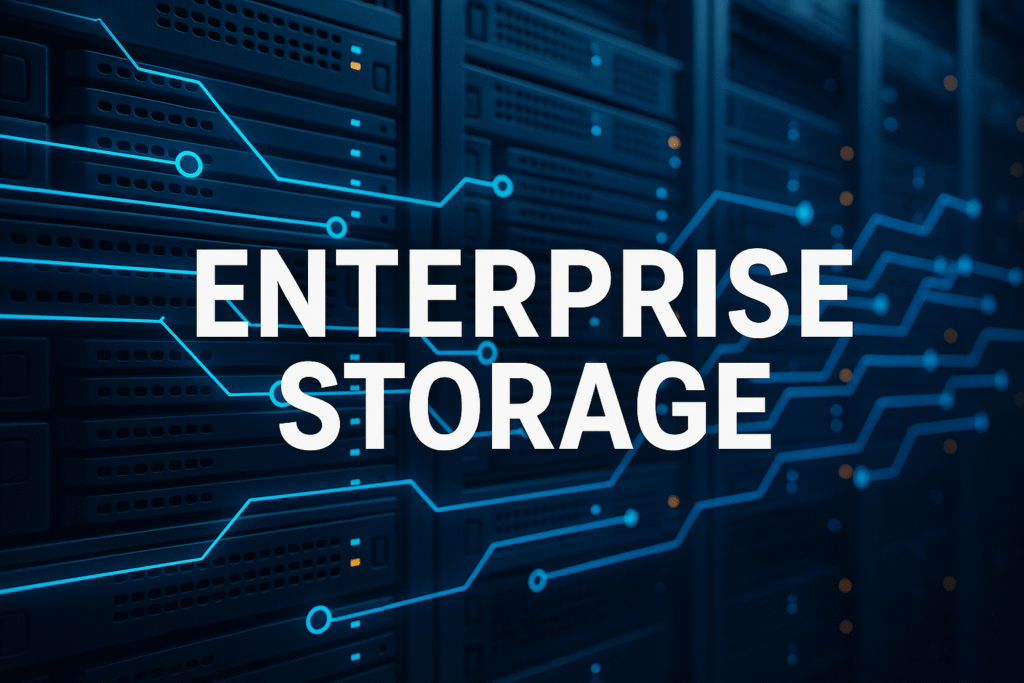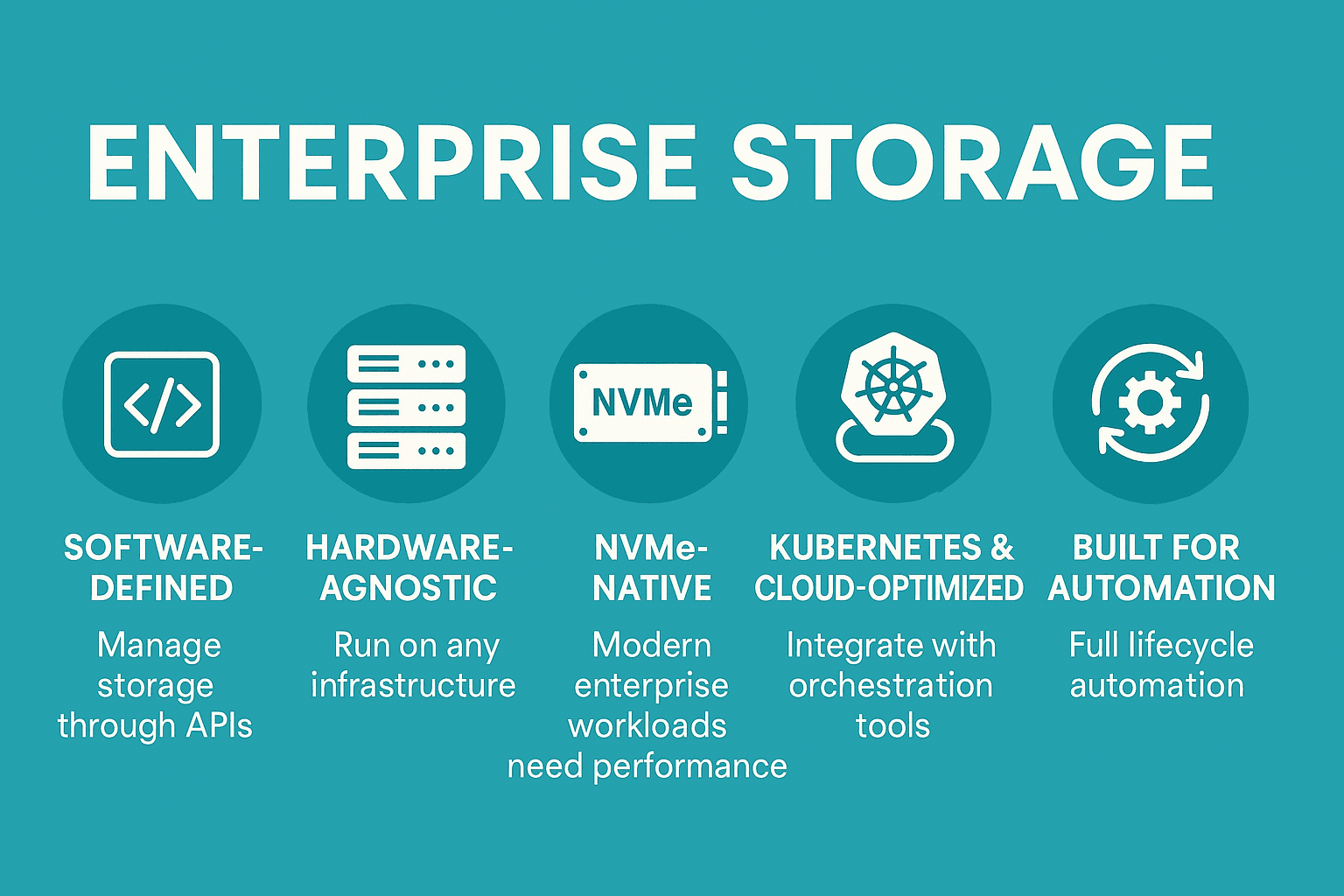
Table Of Contents
- What’s Wrong with Traditional Enterprise Storage?
- What Modern Enterprise Storage Should Deliver
- Choosing Enterprise Storage: Why Flexibility and Speed Matter
- How Traditional Enterprise Storage Compares to Simplyblock
- Why Simplyblock Works for Modern Enterprises
- Why Enterprise Storage Needs to Evolve
- Questions and answers
Enterprise storage is changing fast. The rise of cloud-native applications, AI workloads, and containerized environments is making traditional storage stacks harder to scale, manage, and afford.
By 2025, enterprise storage needs to be more than just reliable—it must be software-defined, hardware-agnostic, NVMe-native, and cloud-optimized. It should deliver flexibility, high performance, and deep automation by default, not as costly extras.
Understanding what’s required from modern storage platforms is key to staying competitive. Simplyblock brings a future-ready architecture that meets these demands without the usual operational trade-offs.
What’s Wrong with Traditional Enterprise Storage?
Legacy storage systems are often tied to specific hardware vendors, rigid architectures, and heavy operational overhead. They were built for static, on-prem environments—not for today’s dynamic, hybrid, and containerized infrastructures.
Here’s where they typically fall short:
- Rigid deployments with vendor lock-in
- Limited automation and manual provisioning
- Slow performance scaling, especially under mixed workloads
- Inefficiencies when used in hybrid or multi-cloud setups
- Incompatibility with Kubernetes-native apps or modern DevOps workflows
Whether you’re managing databases-as-a-service, provisioning for CI/CD pipelines, or building Kubernetes-native backup systems, outdated infrastructure can quickly become your biggest bottleneck.
🚀 Cut Storage Costs Without Slowing Down
Use Simplyblock to run NVMe-native enterprise storage across any cloud or on-prem setup, while optimizing storage tiering and reducing cloud waste.
👉 Use Simplyblock for Cloud Cost Optimization →
What Modern Enterprise Storage Should Deliver
Today’s workloads can’t afford to run on yesterday’s architecture. To stay competitive, enterprise storage should deliver:
✅ Software-Defined
Manage storage through APIs, not hardware interfaces. Software-defined architecture reduces complexity and scales easily without depending on specialized appliances.
✅ Hardware-Agnostic
Run on any infrastructure—bare metal, cloud, or edge—without vendor restrictions. Flexibility is essential for cost control and operational agility.
✅ NVMe-Native
Modern enterprise workloads need performance. With NVMe over TCP, storage systems can achieve local-like latency without custom networking gear.
✅ Kubernetes and Cloud-Optimized
Your storage should integrate with orchestration tools. That means native CSI support, dynamic provisioning, and support for cloud-native databases and stateful apps.
✅ Built for Automation
From snapshots and cloning to scaling and recovery, modern storage needs full lifecycle automation—especially in DevOps-heavy environments.
If your current solution lacks these capabilities, you’re burning time and resources just to maintain it.

Choosing Enterprise Storage: Why Flexibility and Speed Matter
Flexibility and performance aren’t optional anymore—they’re baseline expectations.
If you’re operating across zones or deploying in edge or air-gapped environments, the ability to provision fast, scale intelligently, and maintain low latency is critical.
That’s also true when scaling infrastructure for demanding workloads like disaggregated storage or supporting container-native architectures.
Enterprise IT teams need infrastructure that adapts quickly and delivers predictable performance, even under load.
How Traditional Enterprise Storage Compares to Simplyblock
Choosing the right storage platform is key to meeting modern performance and scalability demands. Below is a direct comparison between Simplyblock and traditional enterprise storage systems.
| Feature | Simplyblock | Legacy Enterprise Storage |
| Architecture | Software-defined, cloud-native | Hardware-centric, on-prem focused |
| Performance | NVMe-native, NVMe/TCP end-to-end | Often SATA/SAS-based |
| Flexibility | Runs on any hardware or cloud | Tied to vendor-specific appliances |
| Automation | Full API/CSI support, DevOps ready | Manual provisioning, limited automation |
| Deployment Options | Kubernetes, OpenShift, hybrid, edge | Mostly static, single-vendor stacks |
| Scale | Elastic, no vendor lock-in | Costly scale-up model |
Why Simplyblock Works for Modern Enterprises
Simplyblock is designed specifically for the way infrastructure works today, not how it worked a decade ago.
🔹 NVMe-native Performance
Delivers high IOPS and low latency using NVMe over TCP. It gives you fast storage without requiring custom hardware.
🔹 Kubernetes and CSI Support
Seamlessly integrates with Kubernetes and OpenShift via CSI. Supports:
- Dynamic provisioning
- Volume expansion
- Snapshots and cloning
Perfect for multi-availability zone recovery and scalable databases.
🔹 Flexible Deployment
Run Simplyblock on any cloud, on-prem hardware, or edge cluster. It’s a match for hybrid, remote, or air-gapped workloads.
🔹 Automation Built-In
Everything from provisioning to backup is API-driven. That keeps your infrastructure agile—and your ops team happy. And for enterprise-level automation, integrating professional services automation software delivers end-to-end visibility and streamlines processes across both infrastructure and service delivery, empowering teams to focus on high-impact, strategic initiatives.
Why Enterprise Storage Needs to Evolve
Storage isn’t just about capacity anymore. It’s about performance, scale, automation, and how well it fits into your infrastructure stack.
As workloads grow more distributed and data-intensive, enterprise storage must support faster cycles, real-time processing, and container-native applications. Static systems can’t handle that pace.
Key attributes like scalability, flexibility, and high availability are now foundational requirements for enterprise storage systems, not optional features.
Questions and answers
Enterprises run mission-critical systems that require continuous availability and seamless expansion. Scalable storage lets you grow capacity without disruption, while resilient design using erasure coding ensures data protection and fault tolerance. Simplyblock’s scale‑out architecture delivers both high performance and enterprise‑grade reliability.
Software‑defined storage separates storage software from the underlying hardware. This allows centralized management, automation, and cost efficiency. Simplyblock implements SDS with advanced orchestration and supports hybrid deployments through its robust NVMe-over‑Fabrics + SPDK technology.
Erasure coding breaks data into fragments plus parity, distributing them across multiple nodes. If some fragments are lost, data can be reconstructed, offering better protection and efficiency than full replication. Simplyblock’s Advanced Erasure Coding strikes a balance between fault tolerance and storage use.
NVMe over Fabrics (NVMe‑oF) brings ultra‑low latency and high bandwidth to networked storage. Protocols like NVMe‑TCP and NVMe‑RoCE enable direct‑attached speed over Ethernet or RDMA, ideal for data‑intensive workloads and time‑sensitive applications.
Yes—modern enterprise storage supports multi-tenant isolation, QoS, and hybrid-cloud operations. Simplyblock’s Multi‑Tenancy & QoS ensures secure, predictable performance across teams or customers, in both on‑prem and cloud settings.
